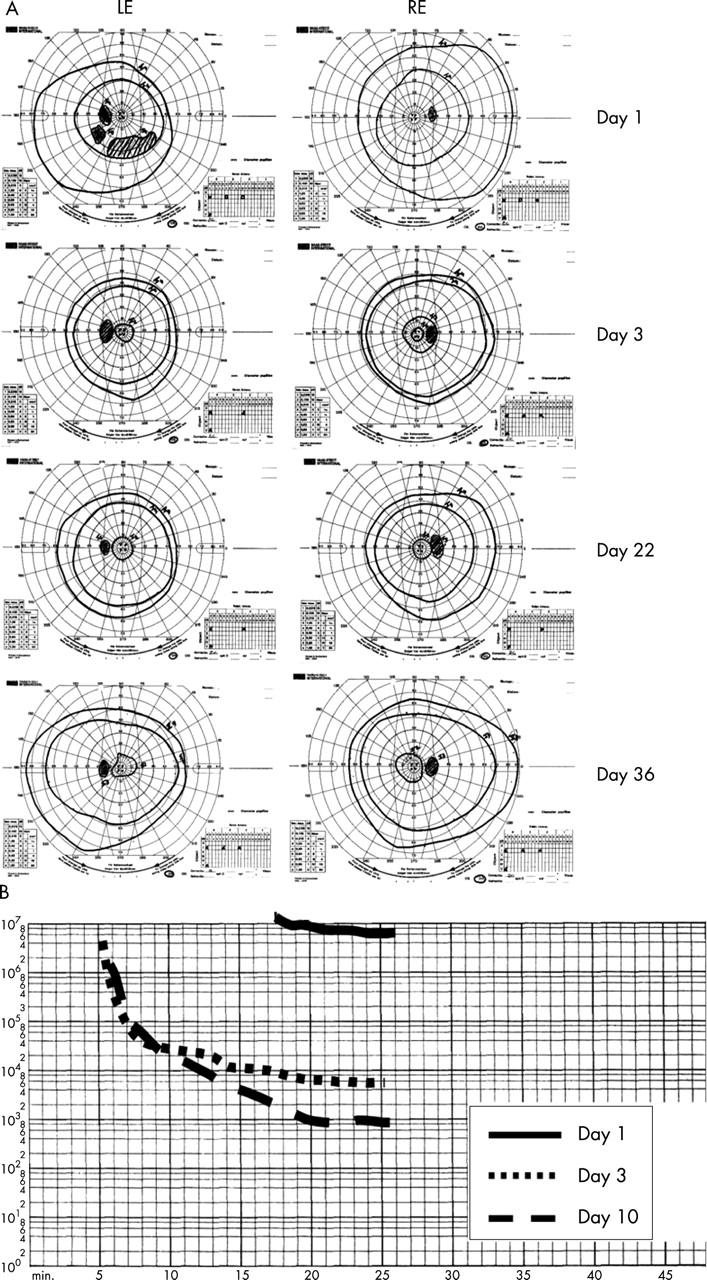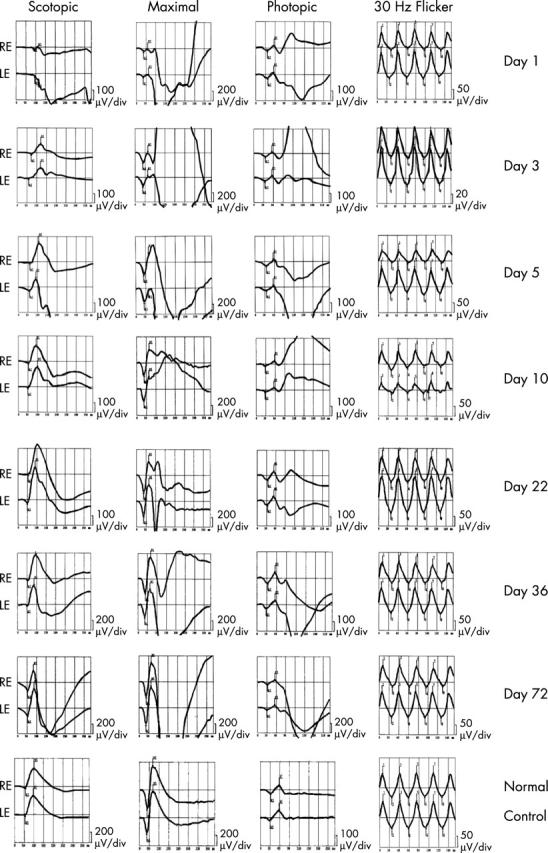Night blindness is the most common and earliest symptom of vitamin A deficiency.1 The latter can be caused by general malnutrition, malabsorption of vitamin A, or impaired vitamin A metabolism due to liver disease.2
Several surgical methods are currently used for the treatment of obesity. In the Scopinaro procedure, a biliopancreatic bypass is combined with a bypass of part of the small bowel, thus promoting intestinal malabsorption.3
The fat soluble vitamin A can exist as retinol, its ester, and retinoic acid. It has several roles in ocular metabolism: it is essential for corneal and conjunctival epithelial cell RNA and glycoprotein synthesis,4 while retinal is the crucial chromophore which combines with both rod and cone opsins to form rhodopsin and activated cone opsins, which are essential for phototransduction.
Case report
A 39 year old man presented with a 6 month history of night blindness, progressing more rapidly in the past 2 weeks. Three years before he had undergone a partial gastrectomy and biliopancreatic derivation for morbid obesity (Scopinaro procedure). His mean body mass index (BMI) decreased from 50 kg/m2 to 31 kg/m2 3 years later.
At presentation, visual acuity was 6/5 in both eyes with a spherical correction of +0.75 dioptres. Slit lamp examination and funduscopy were unremarkable in both eyes. Concentric narrowing in both eyes could be seen on Goldmann visual field (VF) analysis (fig 1A). Goldmann-Weekers dark adaptometry (DA) showed a considerable decrease in sensitivity (fig 1B). Electro-oculography was subnormal before therapy with a lightPeak/darkTrough ratio of 166% for the right eye and 146% for the left eye (normal ratio >180%). ISCEV standard electroretinography5 showed only minimal residual scotopic responses in both eyes. The SRC of vitamin A before therapy was 14 µg/dl (normal range 30–80). Vitamin E levels (0.49 mg/dl; normal 0.5–1.8) and total protein levels were slightly subnormal. Vitamin B and vitamin D levels were normal.
Figure 1.

(A) Goldmann visual field analysis; although peripheral limits as tested with object V4 of Goldmann remained normal, only test object I4 was perceived more centrally, indicating loss of retinal sensitivity. On day 3 of therapy, the patient could already perceive test object I2 and I3 illustrating partial normalisation, while, unexpectedly, peripheral limits were more constricted. From day 36 Goldmann visual fields were considered to be normal. (B) Goldmann-Weekers dark adaptometry (DA) showed considerable decrease in sensitivity before repletion therapy; day 1 is at presentation, before treatment; considerable improvement seen on day 3, with complete normalisation on day 10.
Our patient was given 60 000 IU retinol/day and vitamin E 140 mg/day (Rovigon, Roche).
After only 3 days, partial normalisation of Goldmann VFs occurred. After 3 days of vitamin A supplementation, scotopic ERG responses had already improved to one third of normal (fig 2). Subjectively, the patient reported a “sudden visual recovery” 3 days after initiation of therapy.
Figure 2.

ERGs on day 1 (before treatment) and subsequent days as indicated; normal control for comparison at bottom. At presentation, only minimal residual scotopic responses were seen in both eyes. Amplitudes of oscillary potentials were only residual. Responses to a single bright white flash in the dark adapted eye were minimal, with amplitudes of approximately one quarter of normal for a-wave and 1/13 for b-wave in both eyes. Single flash cone responses still had normal a-waves, while b-waves were two thirds of normal in both eyes. The 30 Hz flicker responses were four fifths of normal in right eye and normal in left eye. After 3 days of vitamin A supplementation, scotopic responses improved to one third of normal in both eyes. Ten days after initiation of treatment, all ERG parameters were within normal limits, although amplitudes still increased up to day 22.
After 5 days of therapy the EOG Lp/Dt ratio returned to near normal.
Ten days after initiation of treatment, all ERG parameters returned to normal (fig 2). Complete normalisation of DA was also seen (fig 1B).
From day 36 Goldmann visual fields were considered to be normal. The ERG (fig 2) and EOG had completely normalised by then.
After 135 days of repletion therapy SRC of vitamin A was still only 26 µg/dl, while vitamin E levels returned to normal (0.6 mg/dl). Treatment was maintained.
Comment
Normal biliary secretion, fat absorption, dietary protein intake, and the presence of zinc are necessary for fat soluble vitamin absorption.6
Vitamin A has a major role in photoreceptor function because it combines, in the form of its 11-cis isomer, with photoreceptor opsins to form rhodopsin and activated cone opsins.
At presentation, the ERG in our patient showed a considerable decrease in rod and, to a lesser extent, in cone function.
After 3 days of vitamin A repletion a significant improvement in the scotopic responses was noted. All ERG responses normalised completely after only 10 days of therapy. This rapid recovery of all electrophysiological and clinical parameters indicates that vitamin A deficiency was still in the earlier stages. The lag between obesity surgery and symptoms can be attributed to the presence of considerable liver stores of vitamin A when surgery was performed.
Our patient was repleted with 15 times the recommended daily allowance (RDA) of retinol (RDA of retinol 4000 IU/day) and 12 times that of vitamin E (RDA of vitamin E 12 IU/day). Interestingly, vitamin E deficiency seems to decrease the amount of vitamin A which can be stored in the retina.7 Long term vitamin replacement therapy is essential after biliopancreatic derivation surgery of the Scopinaro type.
Only a limited number of reports have described cases of vitamin A deficiency following bowel surgery for obesity.
In 1999 Smets et al described a case of night blindness and optic neuropathy after biliopancreatic bypass with normalisation of all electrophysiological parameters when retested after 10 months. No cone dysfunction was reported, despite SRC well below those in our patient.8
In all reports of vitamin A deficiency to date, the rod involvement is seen earlier and is more extensive than cone involvement.9 The reasons for this remain obscure, although rods are known to be more dependent on availability of vitamin A from the retinal pigment epithelium.10
In conclusion, our case proves that malabsorption caused by biliopancreatic derivation surgery of the Scopinaro type can induce vitamin A deficiency with progressive rod-cone dysfunction, as well as deficiencies of all fat soluble vitamins and low plasma proteins.
In the early stages of vitamin A deficiency, recovery of visual function rapidly follows after oral repletion therapy, and can be nearly complete 1 week after initiation of such therapy.
References
- 1.Harris EW, Loewenstein JI, Azar D. Vitamin A deficiency and its effects on the eye. Int Ophthalmol Clin 1998;38:155–61. [DOI] [PubMed] [Google Scholar]
- 2.Groff JL, Gropper SS, Hunt S. Advanced nutrition and human metabolism. St Paul, MN: West Publishing Company, 1995:295–7.
- 3.Scopinaro N, Gianetta E, Civalleri D. Two years of clinical experience with biliopancreatic bypass for obesity. Am J Clin Nutr 1980;33:506. [DOI] [PubMed] [Google Scholar]
- 4.Smith J, Steinemann TL. Vitamin A deficiency and the eye. Int Ophthalmol Clin 2000;40:83–91. [DOI] [PubMed] [Google Scholar]
- 5.Marmor MF, Zrenner E. Standard for clinical electroretinography (1999 update). Doc Ophthalmol 1998;97:143–56. [DOI] [PubMed] [Google Scholar]
- 6.Tsinopoulos I, Nousia-Arvanitakis S, Galli-Tsinopoulou A, et al. Role of electroretinography in the assessment of retinal function as an indicator of vitamin A status. Doc Ophthalmol 2000;101:211–21. [DOI] [PubMed] [Google Scholar]
- 7.Robison WG, Kuwabara T, Bieri JG. Vitamin E deficiency and the retina: photoreceptor and pigment epithelial changes. Invest Ophthalmol Vis Sci 1979;18:683–90. [PubMed] [Google Scholar]
- 8.Smets RM, Waeben M. Unusual combination of night blindness and optic neuropathy after biliopancreatic bypass. Bull Soc Belge Ophtalmol 1999;271:93–6. [PubMed] [Google Scholar]
- 9.Scholl HP, Zrenner E. Electrophysiology in the investigation of acquired retinal disorders. Surv Ophthalmol 2000;45:29–47. [DOI] [PubMed] [Google Scholar]
- 10.Bridges CDB. Retinoids in photosensitive systems. In: Sporn MB, Roberts AB, Goodman DS, eds. The retinoids. New York: Academic Press, 1984:125–76.


